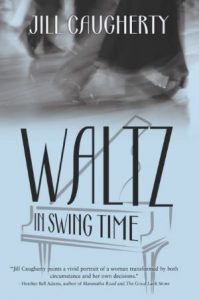Finding the Inspiration to Write Part-Time
 Given the wave of scary, depressing news, it’s often difficult to pick up the proverbial pen, regardless of whether you write for a living or do it part-time. I’m no exception.
Given the wave of scary, depressing news, it’s often difficult to pick up the proverbial pen, regardless of whether you write for a living or do it part-time. I’m no exception.
As my full-time job, I’m a product manager in the high tech industry, where I’ve held a wide range of software development and marketing positions for nearly thirty years. Although I enjoy the analytical aspects of my work, I’ve always longed to be a writer, in much the same way that Irene, the protagonist of my debut novel, Waltz in Swing Time, always longed to become a musician.
When I was six, my parents asked me what I wanted to be when I grew up. As soon as I replied “an author,” they argued it wouldn’t pay the bills. Of course, there was some truth in what they said. Nonetheless, I refused to give up my dream, and while growing up, I wrote poems, plays, novellas, and stories. As an adult, I view my job as a necessary contribution to our family’s finances, and writing as a creative outlet. Eventually, I still hope to write fulltime, because it’s what I love to do. Writing energizes me.
In the meantime, like most part-time authors, I write when I can, which more often than not is a weekend morning or the occasional evening. Maybe having less time to write and viewing it as a treat, not a task, also helps part-timers with the creative process – more so than if writing were a full time gig. In my case, it’s also a welcome break from my day job, which generally uses a different set of skills and requires extensive collaboration.
When I sit down at my personal laptop and open my work-in-process, I re-read a few paragraphs, then slip into the characters’ lives. Through them, I can vicariously experience walking down a San Francisco street, hiking in Yosemite, or performing onstage in a musical. In some ways, in fact, writing isn’t so different from character acting, except the writer can guide the characters and the plot (though some may argue that the characters themselves spring to life and in fact influence the plot), all while exploring deeper truths. So in much the same way that people enjoy reading books and watching TV shows or movies for a little escape, I also write to experiment with different personalities, families, settings, even historical times.
Part-time writers also have the benefit of choosing to leverage a few of the “technical” skills from our day jobs in our writing approaches. For example, I tend to look at the big picture when plotting novels. I don’t start writing until I have a logical, over-arching view of the beginning, middle, and end of the story. Once I’ve created a rough outline of the plot, and have sparked an idea for the protagonist and her conflict, the theme flows naturally. I realize this is a different approach from many writers who play with the idea of a character first, then later evolve that character’s actions into a novel.
The editing process also requires more “technical” skills, including paying attention to detail. Sure, it may not be as fun as the creative part, but it’s equally important to ensure that a character’s actions and dialogue make sense in the context of the greater plot, setting, and time frame. For part-time authors without editors, editing is a necessary evil to hone our descriptions and choice of words, and avoid grammatical and spelling mistakes and other typos.
On the whole, writing part-time can provide balance between full-time “technical” work and free-form creativity. Admittedly, it’s much more difficult to write while anxious or sad. As a result, I haven’t sat down to write creatively as often as usual. I’m sure I’m not alone.
Now, more than ever, writers need to remain persistent in putting pen to paper without growing discouraged. We need this creative outlet in order to stay centered while coping with uncertainty, hardship, and stress. In fact, attempting to center ourselves before writing may help, too. This might mean trying a few minutes of meditation (following the breath while counting backward, for instance), or performing yoga routines via a guided video. It may also include taking a walk outdoors, exercising, chatting with a family member or friend, listening to music, taking a bath, or moving to a different part of the house and changing the lighting.
Afterwards, whether you’re a reader or writer, slip into that other world – one totally different from your current circumstances, and unleash your imagination for a while, absorb yourself in the characters and their adventures. Creative writing, as well as reading and watching movies, can help soothe us and heal our spirits during these difficult times.
Bio: Jill Caugherty is the author of the debut novel WALTZ IN SWING TIME (Black Rose Writing, April 2020). Her short stories have been published in 805Lit and Oyster River Pages. An award-winning marketing manager with over twenty-five years of experience in the high tech industry, she lives in Raleigh, North Carolina with her husband and daughter.
Learn more on her website https://www.jillcaugherty.com
WALZ IN SWING TIME, Jill Caugherty
 Growing up in a strict Utah farm family during the Great Depression, Irene Larsen copes with her family’s hardship by playing piano. Even after an unthinkable tragedy strikes, Irene clings to her dream of becoming a musician. When a neighbor’s farm is foreclosed, Irene’s brother marries the neighbor’s daughter, who moves in with the Larsens and coaches Irene into winning leading roles in musicals. Clashing with her mother, who dismisses her ambition as a waste of time and urges her to become a farmer’s wife, Irene leaves home.
Growing up in a strict Utah farm family during the Great Depression, Irene Larsen copes with her family’s hardship by playing piano. Even after an unthinkable tragedy strikes, Irene clings to her dream of becoming a musician. When a neighbor’s farm is foreclosed, Irene’s brother marries the neighbor’s daughter, who moves in with the Larsens and coaches Irene into winning leading roles in musicals. Clashing with her mother, who dismisses her ambition as a waste of time and urges her to become a farmer’s wife, Irene leaves home.
During a summer gig at Zion National Park, where Irene sings in a variety show for Depression-weary tourists, she meets professional dancer Spike, a maverick who might be her ticket to a musical career. But does pursuing her dream justify the steep price of losing her home and family?
Alternating between Irene’s ninetieth year in 2006 at an assisted living home and her coming-of-age in the thirties, Waltz in Swing Time is a poignant tale of mother-daughter relationships, finding hope amidst loss, and forging an independent path, against all odds. It will resonate with readers of Paula McClain, Rae Meadows, Therese Anne Fowler, and Amy Tan.
“Over the course of this bright novel, Caugherty manages to seamlessly transition between two wildly different decades while maintaining a fresh, youthful voice—which is essential in a book about an ambitious dreamer who struggles through hard times… It’s a hopeful yet realistic story, and the letters that Irene receives from her future husband are a particular joy to read… A reflective tale of growing up creative in a stifling environment and finding true love.” -Kirkus Reviews
“Waltz in Swing Time is a moving account of a life long-lived, the extraordinary stories behind a seemingly ordinary woman. Shifting masterfully between the past and present, Caugherty renders the indignities of old age and the early history of Irene’s life with equal richness. A lovely debut novel from a deft and insightful writer.” Rae Meadows, bestselling author of I Will Send Rain and Mercy Train
BUY THE BOOK HERE
Category: Contemporary Women Writers, How To and Tips






























